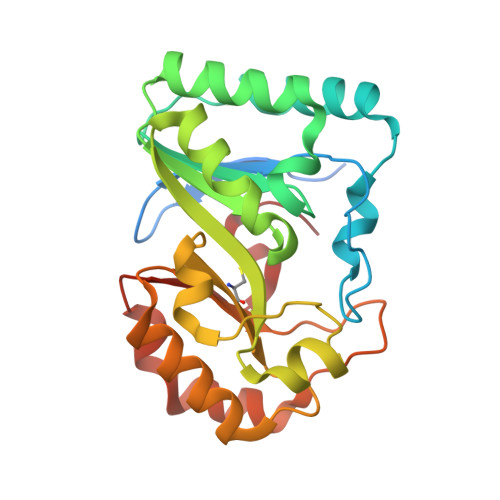Discovery of novel bacterial queuine salvage enzymes and pathways in human pathogens.
Yuan, Y., Zallot, R., Grove, T.L., Payan, D.J., Martin-Verstraete, I., Sepic, S., Balamkundu, S., Neelakandan, R., Gadi, V.K., Liu, C.F., Swairjo, M.A., Dedon, P.C., Almo, S.C., Gerlt, J.A., de Crecy-Lagard, V.(2019) Proc Natl Acad Sci U S A 116: 19126-19135
- PubMed: 31481610
- DOI: https://doi.org/10.1073/pnas.1909604116
- Primary Citation of Related Structures:
6P78 - PubMed Abstract:
Queuosine (Q) is a complex tRNA modification widespread in eukaryotes and bacteria that contributes to the efficiency and accuracy of protein synthesis. Eukaryotes are not capable of Q synthesis and rely on salvage of the queuine base (q) as a Q precursor. While many bacteria are capable of Q de novo synthesis, salvage of the prokaryotic Q precursors preQ 0 and preQ 1 also occurs. With the exception of Escherichia coli YhhQ, shown to transport preQ 0 and preQ 1 , the enzymes and transporters involved in Q salvage and recycling have not been well described. We discovered and characterized 2 Q salvage pathways present in many pathogenic and commensal bacteria. The first, found in the intracellular pathogen Chlamydia trachomatis , uses YhhQ and tRNA guanine transglycosylase (TGT) homologs that have changed substrate specificities to directly salvage q, mimicking the eukaryotic pathway. The second, found in bacteria from the gut flora such as Clostridioides difficile , salvages preQ 1 from q through an unprecedented reaction catalyzed by a newly defined subgroup of the radical-SAM enzyme family. The source of q can be external through transport by members of the energy-coupling factor (ECF) family or internal through hydrolysis of Q by a dedicated nucleosidase. This work reinforces the concept that hosts and members of their associated microbiota compete for the salvage of Q precursors micronutrients.
Organizational Affiliation:
Department of Microbiology and Cell Science, University of Florida, Gainesville, FL 32611.


















